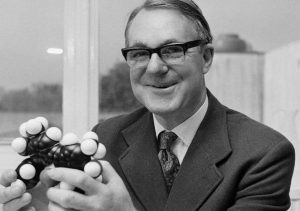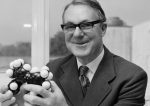The Australian chemical industry has hired more than 50 thousand people and contributes around $145 million annually to the Australian economy along with other science fields. Chemistry is still the more popular science field among the other.
There are many Australian chemist that has impact in the Chemistry field. Here are the list of chemist in Australia and their contribution:
1. John Cornforth
 Sir John Warcup Cornforth Jr. (Born September 7th 1917) was an Australian–British chemist. He was notable for winning the Nobel Prize in Chemistry for his work on the stereochemistry of enzyme-catalysed reactions in 1975. In 1993, Sir John Cornforth got admitted to University of Oxford by winning the 1851 Research Fellowship from the Royal Commision for the Exhibition of 1851.
Sir John Warcup Cornforth Jr. (Born September 7th 1917) was an Australian–British chemist. He was notable for winning the Nobel Prize in Chemistry for his work on the stereochemistry of enzyme-catalysed reactions in 1975. In 1993, Sir John Cornforth got admitted to University of Oxford by winning the 1851 Research Fellowship from the Royal Commision for the Exhibition of 1851.
At the University of Oxford, Sir John Cornforth joined a team that developed the penicillin antibiotic. After finishing the developing of the antibiotic, he focused on his own chemistry research about stereochemistry from various chemical reaction. In that research, Sir John Cornforth, with the help of Vladimir Prelog, studied an enzyme that activates the changes in chemical compounds. The result of that research helped in the growth of many other research, the notable one was the discovery of cholesterol-lowering drugs.
Several papers that he co-worked can be seen as listed below.
- Stereochemistry of enzymic hydrogen transfer to pyridine nucleotides (1962) (Read: Stereochemistry of Organic Chemistry)
- Studies in the series of 4-substituted quinolines (1948)
- Antituberculous effects of certain surface-active polyoxyethylene ethers (1955)
- Substrate stereochemistry of the hydroxymethylglutaryl CoA lyase and methylglutaconyl CoA hydratase reactions (1975)
- Enzymes and stereochemistry Tetrahedron (1974)
- The chiral methyl group–its biochemical significance (1970)
- Chemistry of mevalonic acid (1969)
- Studies on the biosynthesis of cholesterol XIX. Steric course of hydrogen eliminations and of C-C bond formations in squalene biosynthesis (1966)
- Isolation of sycamore dormin and its identity with abscisin II Tetrahedron (1966)
- The biosynthesis of polyisoprenoids (1961)
- A stereoselective synthesis of squalene (1959)
- Experiments on the synthesis of substances related to the sterols (1946)
- The preparation of β-tetralone from β-naphthol and some analogous transformations (1942)
- Nuclear methylation of phenols by means of methanolic sodium methoxide (1942)
- Structure of a naturally occurring antagonist of dihydrostreptomycin (1956)
- Influence of carbohydrate metabolism on bacterial allergy; its relation to cortisone desensitisation (1953)
2. David Buckingham
 Amyand David Buckingham (Born January 28th 1930) is an Australian chemist who primarily focused in chemical physics. A. David Buckingham was appointed Professor of Chemistry at the University of Cambridge (United Kingdom) and he is currently the Emeritus Professor at the same university. Professor Buckingham’s focused on the measurement and understanding of the electric, magnetic and optical properties of molecules.
Amyand David Buckingham (Born January 28th 1930) is an Australian chemist who primarily focused in chemical physics. A. David Buckingham was appointed Professor of Chemistry at the University of Cambridge (United Kingdom) and he is currently the Emeritus Professor at the same university. Professor Buckingham’s focused on the measurement and understanding of the electric, magnetic and optical properties of molecules.
One of his notable contribution in scientific research is the theory of intermolecular forces. He has also co-worked with other scholars regarding to Chemistry-related research like The Hydrogen Bond and many more that can be found in scholar publication sites. Several Buckingham’s work can be seen as listed below.
- Direct Method of Measuring Molecular Quadrupole Moments (1959)
- The Quadrupole Moment of the Carbon Dioxide Molecule (1963)
- Solvent Effects in Nuclear Magnetic Resonance Spectra (1960)
- Solvent Effects in Vibrational Spectroscopy (1960)
- Effects of a strong electric fields on NMR spectra (1962)
- Polarizability and Hyperpolarizability of the Helium Atom (1968)
- Rayleigh and Raman Scattering from Optically Active Molecules (1971)
- Linear and Nonlinear Light Scattering from the Surface of Liquids (1990)
- The Theoretical Background to Vibrational Optical Activity (1994)
(Read: Chemists Who Contributed in the Development of the Periodic Table)
3. Arthur Birch
Arthur John Birch (Born August 3rd 1915) was an Australian organic chemist who was notable for developing the Birch reduction of aromatic rings which is widely used in synthetic organic chemistry. Birch’s development (The Birch Reduction) enables the modification of steroids, which is a biologically active organic compound with four rings arranged in a specific molecular configuration.
The Birch reduction also allows the development of steroid drugs and antibiotics. Arthur Birch also made the first simple synthesis of the ring A-B structure of cholesterol. Throughout his career span, Birch has published over 400 scientific papers and reports. Several works by Birch is mentioned as listed.
- The detection and estimation of α-phellandrene in essential oils (1937)
- Isonitroso-α-thujene (1938)
- The α-phellandrene fraction of eucalyptus oils (1938)
- A new reagent for primary and secondary amines (1944)
- Experiments on the synthesis of substancesrelated to the sterols (1944)
- Metal–ammonia solutions (1948)
- Hydroaromatic steroid hormones. Part I. 10-Nortestosterone (1950)
- The reduction of organic compounds by metal-ammonia solutions (1950)
- The volatile oil of Metrosideros scandens (1953)
- The Birch reduction inorganic synthesis (1996)
(Read: Chemists who Work in The Biotechnology Field)
4. Adrien Albert
Adrien Albert (Born November 19th 1907) was an important figure in Australia. He was the one who introduced Medicinal Chemistry discipline within Australia. Albert also authored many books on Chemistry, like one on selective toxicity which is probably Albert’s contribution to the medicinal chemistry.
He also had a great contribution regarding a research in heterocyclic chemistry. That research, was later, made into a book entitled Heterocyclic Chemistry which was first published in 1959. (Read: Chemists Who Worked on The Manhattan Project)
5. David P. Craig
David Parker Craig (Born December 23rd 1919) was an Australian chemist. He was the Emeritus Professor at the Australian National University in Canberra. He was notable for his contribution in Physical Chemistry and
Theoretical Chemistry to the Australian society. Craig’s best-known research includes the fields of quantum theory and spectroscopy of aromatic molecules, molecular crystals, quantum electrodynamics and chirality. He also contributed in cyclic inorganic systems such as phosphonitrilic halides. (Read: Chemists Who Design Fireworks are Experts on Many Kinds of Explosions)
6. Edward Rennie
Edward Henry Rennie (Born August 19th 1852) was an Australian Scientist. Rennie was best known for becoming the president of the Royal Society of Australia. He also studied the development of chemical manufacture.
Besides becoming the president of the Royal Society, Rennie had also become the president of the Australian Chemical Institute and president of the Australian Association for the Advancement of Science.
7. Alexander Boden
Alexander Boden (Born May 28th 1913) was an Australian manufacturing chemist, author and publisher (of science textbook), and philantropist. Boden had a great contribution in publishing a book in chemistry. His notable book was A Handbook of Chemistry which was the first book that he authored. Other books that he published includes:
- An Introduction to Modern Chemistry (1946)
- Senior Chemistry (1962)
- Introduction to Science for High School Students (1964)
- Chemtext: Chemistry for Senior Students (1986)
8. Cyrill P. Callister
Cyrill Percy Callister (Born February 16th 1893) was an Australian chemist and food technologist. Callister was notable for developing the Vegemite yeast spread.
Indeed, that’s the best list of chemist in Australia and their contribution. Their achievements in Chemistry field has been so useful for us now in today’s life.

